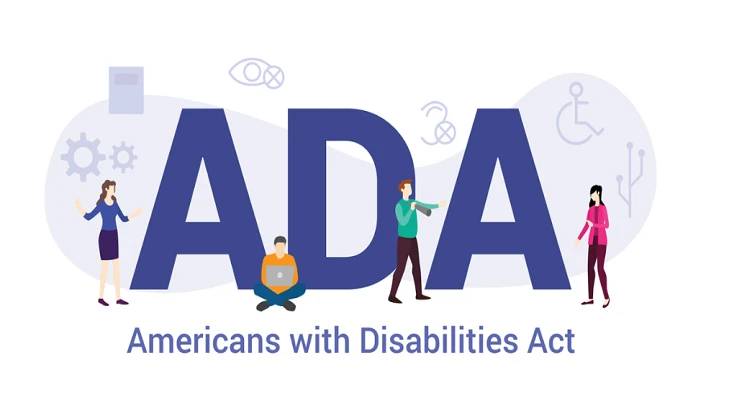- Author: Richard Stim
- Jul 02, 2025
In 1990, Congress passed the Americans with Disabilities Act (ADA). The Americans with Disabilities Act helps people struggling with disabilities to prevent hiring and workplace discrimination. The ADA applies primarily to private businesses with 15 or more employees.
The ADA policy covers employment agencies, government employers, and labor unions. The act also focuses on increasing accessibility and mobility for people with disabilities by providing the necessary means that will help them in businesses and public places. Let's delve deeply into the meaning of the Americans with Disabilities Act, its guidelines, rights, and protections.
What is the Americans with Disabilities Act (ADA)?
The Americans with Disabilities Act (ADA) refers to a federal civil rights law that prohibits discrimination against people who are struggling with disabilities in different areas. These include:
- Employment
- Transportation
- Communications
- You can access state and local government services and programs.
- Public accommodations
The ADA protects people who struggle with disabilities from any form of discrimination. ADA disability rights are civil rights. The ADA is a law that safeguards people struggling with disabilities in various areas of public life.

What Are the Types of ADA?
The ADA will cover a person's disability if a physical or mental impairment significantly limits their ability to perform daily activities. There are four fundamental sections that comprise the protections under the ADA.
-
Title I: ADA Title I protections will prohibit discrimination against individuals struggling with disabilities in the job application procedure, firing, hiring, and other employment aspects.
-
Title II: This title is applicable to both state and local government entities. It extends the protection of individuals from discrimination to individuals with disabilities for reasonable access to programs and services provided by the government.
-
Title III: ADA Title III protections will prohibit discrimination against disabled people in accessing public venue activities. These may include restaurants, daycare facilities, recreation facilities, movie theaters, and other places open to the public. Title III also applies to commercial and nonresidential facilities, such as warehouses, factories, and office buildings.
-
Title IV: It will oversee telephone and television access for people who are struggling with hearing and speech disabilities.
What Are The Principles Of The ADA?
Five fundamental principles, historically viewed as civil rights for individuals struggling with disabilities, form the foundation of the ADA:
- Focus on the individual.
- Integration;
- Equal opportunity;
- Physical accessibility and
- Provide reasonable Americans with Disabilities Act accommodations, auxiliary aids, and other services.
What are ADA guidelines?
The Americans with Disabilities Act (ADA) sets specific accessibility standards for
- Public accommodation
- Commercial facilities
- State and local government facilities are located in new construction and other industries.
The Access Board has set minimum guidelines for ADA standards.
Americans With Disabilities Act History
The ADA Act defines disability as a physical or mental impairment that limits one or more major life activities. President George H.W. Bush signed this into law on July 26, 1990.
In 2008, the ADA Amendments Act (ADAAA) was signed, indicating the expansion of the ADA Act. It came into effect at the start of 2009.
Some sections also became effective for the ADA.
-
Section 504 of the Americans with Disabilities Act.
Under Section 504, employers and organizations are forbidden from denying or excluding individuals with disabilities equal opportunities that will help them receive services and program benefits.
-
Section 508 of the Americans with Disabilities Act.
Agencies are required under Section 508 of the Rehabilitation Act (29 U.S.C. 794d), amended in 1998, to provide people with disabilities equal access to electronic information compared to those without disabilities.
How Do We Handle Employees' Requests for ADA Accommodation?
There are various steps when you handle the request for accommodation from the employees.
Step 1: You need to determine whether the employer is covered by the ADA or not
Step 2: Ensure an ADA compliance policy exists for handling requests for accommodation
Step 3: Determine whether an employee having a disability is qualified or not by the ADA enforcement agency
Step 4: Initiate the Americans with disabilities act interactive process
After these steps, the ADA implementation procedure will begin
The Americans With Disabilities Act Has Significantly Enhanced Accessibility.
The Americans with Disabilities Act will establish standards for accessibility in public accommodations. These may include creating automatic ramps, doorways, and elevators that will make it easier to accommodate wheelchairs. We must design water fountains at a height that disabled individuals can easily reach.
Here are some additional examples of workplace accommodations:
- Providing a hearing-impaired applicant with a sign language interpreter during a job interview can be beneficial.
- Changing the work schedule to meet the needs of an individual who may require medical treatment
- We are restructuring an existing facility to make it accessible to individuals struggling with disabilities.
However, an employer is prohibited from providing reasonable accommodations if doing so would result in undue hardships for the business and unnecessary expenses, given the size of the company. According to Title IV of the ADA, people with hearing and speech issues will receive telephone relay services from telephone companies.
Does the ADA apply to non-US citizens?
No, the ADA does not apply to non-US citizens.
To determine whether the ADA applies to an employee or employer in foreign countries, you must look at both of them. For ADA to apply, the employee must be a US citizen. According to the ADA, foreign employees who are working in other countries have no protection.
How can a lawyer help if your disability is not included in the ADA?
There may be situations where you are unaware of whether your disability meets the eligibility criteria of the ADA. In such disability cases, a Social Security Disability Attorney will be there to support you and provide you with the right legal advice according to your medical records and other relevant documents. They will also help you file a disability claim and pursue the Social Security disability benefits that you deserve.
FAQs on the Americans With Disabilities Act (ADA)
1 . What is the ADA's Title II (Local and State Government)?
Title II of the ADA states that no qualified individual struggling with a disability will receive a denial from any of the following:
-
Participation in programs or services is excluded.
-
Public entities, including state and local governments and their respective departments, engage in various activities.
-
No entity will discriminate against me.
2. WHAT IS REASONABLE ACCOMMODATION?
A reasonable accommodation is an adjustment or modification to the work environment or job that will enable an employee with a disability to perform an important job function or participate in the application process.
3. Under the ADA, what is a disability?
According to the ADA, a disability refers to a mental or physical impairment that limits the ability of an individual to engage in major life activities such as walking, hearing, speaking, seeing, breathing, or working.
4. WHAT IMPAIRMENTS WOULD GENERALLY NOT MEET THE DEFINITION OF DISABILITY?
Some impairments that do not meet the definition of disability are minor medical conditions or short-duration non-chronic conditions, such as flu or sprains, which will not be covered.
5. Who do I contact to discuss an ADA accommodation?
An individual who is struggling with disability must contact the ADA coordinators to discuss their accommodation. You can contact these coordinators by phone, in writing, or in person. However, you must ensure that these requests are specific to the purpose and submitted at least 5 days in advance. You can also contact the Office of Equity and Civil Rights, Disabilities Division, via email or phone.
6. How will we handle the accommodation request?
The ADA coordinator is responsible for informing you whether the city will accommodate your request or not. They may also provide you with an alternative form of accommodation. If they deny both, you must provide a detailed written explanation.
7. How do I file a grievance if the ADA denies my request?
If the ADA denies your application, you can file a grievance with the Equal Employment Opportunity Commission (EEOC) or California’s Civil Rights Department. The EEOC is a federal agency that will enforce the ADA.


